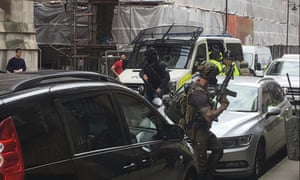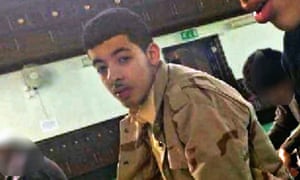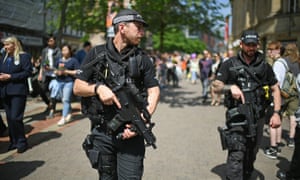Shortly before 11am on Saturday, military bomb disposal experts swooped on a terraced house in Manchester. Such sights are the new reality, as the city begins adjusting to life on the front line of the war on terror.
Even as daylight broke over Manchester Arena on Tuesday following the attack, investigators had concluded that the suicide bomber, Salman Abedi, was no solitary actor, no lone wolf. The 22-year-old required considerable support in carrying out the arena attack, which was timed to cause carnage during the heady moments when the pop star Ariana Grande finished her encore.
The first clue came in the device itself. Forensic analysts realised it had been crafted with cunning. The shrapnel was evenly spaced to inflict maximum damage and it had a back-up detonation system. Building an effective bomb is tricky. The Manchester attack was the first time Islamist terrorists have successfully used explosives in Britain since 2005.
The second clue emerged less than 24 hours after Abedi killed 22 people and injured 116. Intelligence from the Joint Terrorism Analysis Centre confirmed that there was the risk of a follow-up attack. Theresa May announced she was raising the threat level to critical, its highest, signalling that another terrorist atrocity was expected imminently.
Put simply, the bomb maker was either still at large or Abedi had distributed more devices to his co-conspirators. The race to trace the terror network had begun.
Six days after the attack, it is a race the police feel they are winning. Manchester’s chief constable Ian Hopkins confirmed the investigation had made “significant progress” dismantling the network behind Britain’s worst terror attack in more than a decade. Hours earlier, just before midday, the threat level had been downgraded to severe.
Even so, Britain’s most senior counter-terrorism officer, Mark Rowley – the Met’s assistant commissioner for specialist operations – said more arrests will follow. Police held two more suspects in dawn raids on Saturday, with 11 men now being questioned. The true size and scope of Abedi’s network has still been not fully established.
The sharp end of the inquiry is focused on Manchester, but even as the net draws tighter on Abedi’s cell, the investigation’s tentacles are stretching further. Away from the red-brick streets of England’s north-west, it has moved to Abedi’s Libyan connections and on to the streets of Tripoli and its mishmash of jihadist militias.So far, 14 locations across Greater Manchester have been searched. One Cheetham Hill home raided on Saturday had its doors blown off before being stormed by police. Another key building is Granby House, a 1908 red-brick building close to the city’s Piccadilly station. Here, last weekend, inside a one-bedroom apartment, investigators believe Abedi may have helped to assemble the bomb’s chief components.
Islamic State’s claim of responsibility for the attack has prompted the intelligence agencies to scour the identities of senior Isis operatives and foreign fighters holed up in the Syrian and Iraqi cities of Raqqa and Mosul.
Abedi’s links to Europe are slowly emerging. German officials are investigating a possible connection to Frankfurt, the largest financial centre on the continent. In the aftermath of the attack, officials in Brussels, an established jihadi hotspot, said there was no link, but that position has since begun to alter.
A paradox of complex counter-terrorism investigations is that the more progress made, the slower and more cumbersome the inquiry can become. Every house raided, each individual arrested creates more leads, and more blind alleys that must be investigated.
Sources close to the investigation reveal they have approached technology firms to help access machines, saying they expect to “amass hundreds of electronic devices” during the investigation into Abedi’s terror cell. Greater Manchester Police said they were pursuing 1,500 “actions”.Every telephone, handset and computer has now to be meticulously examined by the North West Counter Terrorism Unit, each a potentially gigantic source of data.
“The further it progresses, the more work, the more phones to search through. Investigations can be peculiar things; after the arrest phase is when the real work begins,” said a source.
Adding to the information flow is the granting of IoC (interception of communications) powers that enable the security services to listen to calls and read emails. A 1,000-strong investigations team, working 14-hour shifts 24/7 has been formed to chase leads and evaluate data.
A primary focus of the investigation for several days has been tracking the forensic footprint of the bomb itself. A team of Metropolitan Police officers has mounted a large-scale financial investigation into where, how and by whom the device’s chemicals were acquired, as well as ascertaining if the men who are in custody can be linked to such transactions. The bomb contained TATP – triacetone triperoxide – the same explosive as was used in the November 2015 attacks in Paris, the Brussels attack in March 2016 and the July 2005 London attacks, and a high explosive frequently favoured by terrorists because its ingredients are readily found at chemists or hardware stores.
Detectives are also analysing database algorithms designed to spot terrorist tradecraft and terabytes of chatter that record the various aliases and movements of “subjects of interest”. Much of this requires UK officials liaising bilaterally with European police forces or issuing requests to Europol, Interpol and American officials in relation to Libya.Europe’s colossal databases are pivotal, principally the Schengen Information System, which includes details of criminals along with 8,000 terror suspects and which last year was used by UK police 58,694 times an hour.
As police close in on Abedi’s network, its international reach means that other characters have emerged that may be of interest. Among these is a shadowy logistics expert based in Brussels known only as Obaida and who, it is believed, may have acted as a crucial cog in the support network of an active Manchester cell over several years, enabling terrorists to flit through European capitals and on to Libya and Syria and back.
Greater Manchester police have been cooperating with forces and secret services in Belgium, and US security officials have said Abedi’s bomb suggested a “level of sophistication” that implied its maker had foreign training.
Immediately after the Manchester attack, Belgium’s Threat Analysis Co-ordination Body said that, after an initial intelligence analysis, a link between Belgium and the Manchester bombing had not been found. But by Friday a spokesman for OCAM was unwilling to repeat that position and declined to explain.
Obaida first came to the attention of the British security services during an investigation into a friend of Abedi’s, Abdalraouf Abdallah, 23. Twelve months ago, Abdallah, a Libyan refugee who lived 15 minutes’ walk from Abedi in Manchester, was sentenced to five and a half years for terrorism offences. During the trial, Obaida was named as a key figure “facilitating the movements of terrorists across mainland Europe”.
In a pre-sentencing hearing judgment, Lord Justice Treacy described Abdallah as being “active in a terrorist group based in Manchester in 2014”.
Treacy’s judgment added: “Abdallah organised the terrorist activities of the Manchester group. The group used shared contacts to facilitate movement through Europe to the Syrian border. It was also involved in arrangements for the purchase and supply of weapons.”
A second leg of the Brussels investigation is examining whether Abedi had links to the so-called “man in the hat” caught on cameras at Brussels airport shortly before it was bombed, believed to be the Belgian Mohamed Abrini. Abrini visited Manchester in 2015 and has since been charged with involvement in the Paris terrorist attacks.In Germany, separate investigations into Abedi are also ongoing. The Bundeskriminalamt (BKA) of North Rhein-Westphalia is scouring CCTV footage from Dusseldorf airport where Abedi, on his way back from Libya to Manchester, spent four hours just days before his attack.
German authorities describe their investigation as “intensive and urgent” after it emerged that Abedi had visited the country in 2015, spending time in Frankfurt.
Both Frankfurt and Dusseldorf are home to more than a thousand suspected Islamists, and counter-intelligence experts from the police and BKA are looking into any potential contacts Abedi may have had with radical German Islamists. Dusseldorf is just 150 miles from Brussels, where Obaida was last known to be based. A possible German chapter of the Abedi network may yet surface.
Eleven days before a general election it was highly likely that the fallout from the atrocity would become politicised. There have been accusations that budget cuts to community policing had left Manchester without the intelligence needed to keep it safe.
Manchester’s mayor, Andy Burnham, waded into the debate on Saturday, suggesting the public would be prepared to pay more to bolster police numbers. The city has lost 2,000 officers since 2010.
Resources also determine the efficacy of the security services. The home secretary Amber Rudd has admitted Abedi was known to intelligence agencies “up to a point” but following a single terror suspect covertly 24 hours a day requires a huge team of up to 36 intelligence officers. Tough decisions are required over who gets the full surveillance treatment. Wherever Abedi started in the prioritisation system, he ended up at the bottom of the list, and the security services are looking into whether there was “actionable” intelligence that may have been ignored.
Various calls have also been made to review Britain’s entire counter-terror infrastructure, even including demands for the reintroduction of internment.
Predictably, yet more scrutiny has fallen on Prevent, the government’s counter-radicalisation strategy. Prevent has been dogged with claims that its activities are sowing mistrust and fear in the Muslim community. Abedi was reported to Prevent following concerns over his radical views long before his attack.Fiyaz Mughal, founder of the anti-extremist organisation Faith Matters, said that the episode further exposed failures of officials to act on indicators of radicalisation. “Assessments by skilled professionals should show up which individuals may be at risk of extremism and violent extremism. It is an exact trajectory that I have seen in cases before. This is a well worn path, sadly.”
Fresh twists lie ahead but the immediate risk of another attack in Manchester appears to have been neutralised, the central protagonists rounded up and detectives increasingly emboldened by the investigation’s success. Steadily, police are learning how the device was made.
On Saturday, Rowley, who is also anti-terrorism policy lead for the National Police Chiefs’ Council, implied the initial phase of the investigation was nearing its endgame, yet was canny enough to make room for any unexpected development. “We are getting a greater understanding of the preparation of the bomb. There is still much more to do.”





0 comments:
Post a Comment